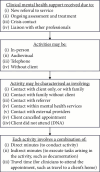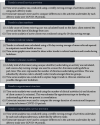Environmental Factors for Sustained Telehealth Use in Mental Health Services: A Mixed Methods Analysis
- PMID: 39314675
- PMCID: PMC11419844
- DOI: 10.1155/2024/8835933
Environmental Factors for Sustained Telehealth Use in Mental Health Services: A Mixed Methods Analysis
Abstract
Background: The mental health service delivery gap remains high globally. Appropriate telehealth use may increase capacity through flexible remote care provision. Despite the historical lack of telehealth integration into publicly funded mental health services, during COVID-19 lockdowns, services rapidly switched to telephone and audiovisual care provision. In Aotearoa New Zealand (NZ), this was abandoned when no longer required by COVID-19 restrictions. This study explores environmental factors associated with telehealth implementation and ongoing use or discontinuation across a multiregional outpatient mental health service. This work contributes to understanding system-level factors influencing telehealth use and thus informs policy and practice in postpandemic environments. Methods: This mixed methods study applied an interpretive description methodology. Semistructured interviews with 33 mental health clinicians were thematically analysed. Qualitative findings were reframed and evaluated using time series analyses of population-level quantitative data (prior to and throughout the pandemic). Findings were synthesised with qualitative themes to develop an understanding of environmental factors contributing to telehealth use. Results: Findings highlighted an increase in clients assessed by mental health services and declining clinician numbers, contributing to pressure placed on clinicians. There was a lack of culture supporting telehealth, including limited awareness, leadership, and champions to facilitate implementation. Some teams provided services suited to telehealth; other subspeciality teams had limited applications for telehealth. There was a general lack of policy and guidelines to support telehealth use and limited technical support for clinicians unfamiliar with audiovisual software. Conclusion: Disorganised telehealth adoption in the study regions provides insight into wider environmental drivers affecting telehealth uptake. For telehealth to become a workable service delivery mode following COVID-19, stewardship and culture shifts are required, including policy development, technical support, and resources to support clinical teams. Telehealth may address growing service demand by improving interfaces with primary care and providing timely access to specialist input.
Keywords: clinician; interpretive description; mental health services; mixed methods research; telehealth.
Copyright © 2024 Benjamin Werkmeister et al.
Conflict of interest statement
The lead author worked in the outpatient services within the study region, as a psychiatric registrar (physician training in psychiatry).
Figures











Similar articles
-
Global Implications From the Rise and Recession of Telehealth in Aotearoa New Zealand Mental Health Services During the COVID-19 Pandemic: Mixed Methods Study.JMIR Form Res. 2023 Sep 22;7:e50486. doi: 10.2196/50486. JMIR Form Res. 2023. PMID: 37738075 Free PMC article.
-
Mental Health Client Experiences of Telehealth in Aotearoa New Zealand During the COVID-19 Pandemic: Lessons and Implications.JMIR Form Res. 2023 May 26;7:e47008. doi: 10.2196/47008. JMIR Form Res. 2023. PMID: 37234041 Free PMC article.
-
Implementation of telehealth primary health care services in a rural Aboriginal Community-Controlled Health Organisation during the COVID-19 pandemic: a mixed-methods study.Rural Remote Health. 2023 Aug;23(3):7521. doi: 10.22605/RRH7521. Epub 2023 Aug 7. Rural Remote Health. 2023. PMID: 37545165
-
"A decade's worth of work in a matter of days": The journey to telehealth for the whole population in Australia.Int J Med Inform. 2021 Jul;151:104483. doi: 10.1016/j.ijmedinf.2021.104483. Epub 2021 May 7. Int J Med Inform. 2021. PMID: 33984625 Free PMC article. Review.
-
Service design for children and young people with common mental health problems: literature review, service mapping and collective case study.Health Soc Care Deliv Res. 2024 May;12(13):1-181. doi: 10.3310/DKRT6293. Health Soc Care Deliv Res. 2024. PMID: 38767587 Review.
References
-
- World Health Organization. World Mental Health Report: Transforming Mental Health for All . World Health Organization; 2022. https://iris.who.int/bitstream/handle/10665/356119/9789240049338-eng.pdf... .
-
- Ministry of Health. Office of the Director of Mental Health and Addiction Services: Annual Report 2017 . Ministry of Health; 2019. https://www.health.govt.nz/publication/office-director-mental-health-and... .
-
- Te Pou o te Whakaaro Nui. Workforce stocktake . Te Pou; 2018. https://mentalhealth.inquiry.govt.nz/assets/Summary-reports/Te-Pou-Stock... .
-
- New Zealand Government. He Ara Oranga: Report of the Government Inquiry into Mental Health and Addiction . Government Inquiry into Mental Health and Addiction; 2018. https://mentalhealth.inquiry.govt.nz/assets/Summary-reports/He-Ara-Orang... .
LinkOut - more resources
Full Text Sources
Miscellaneous

